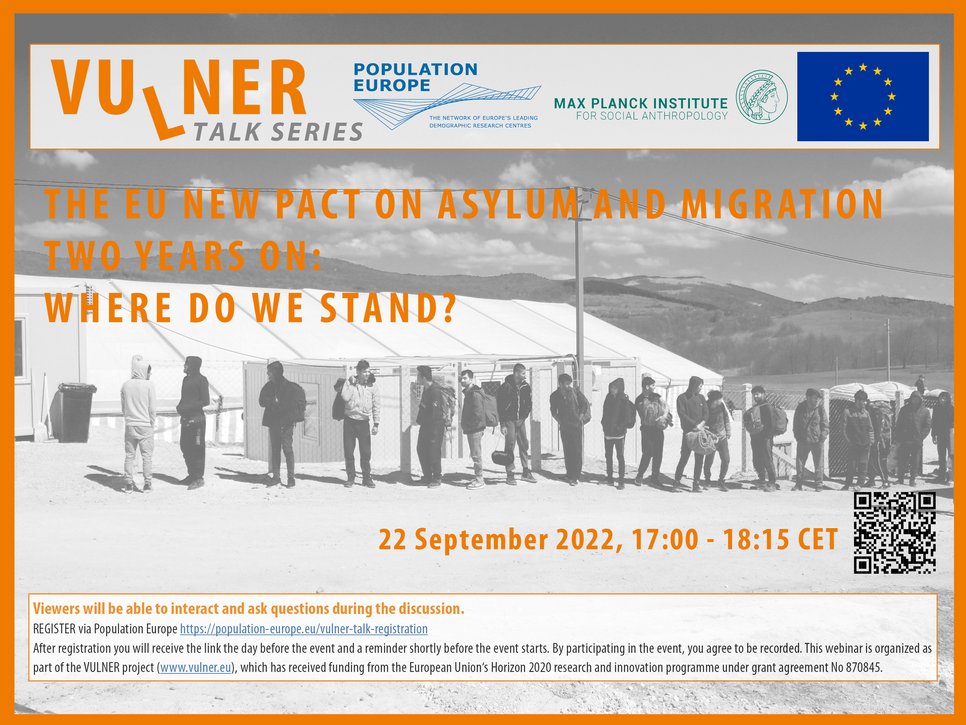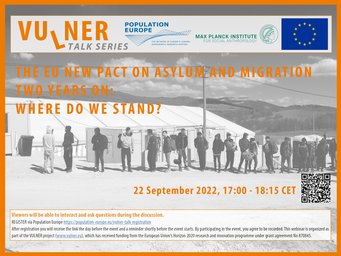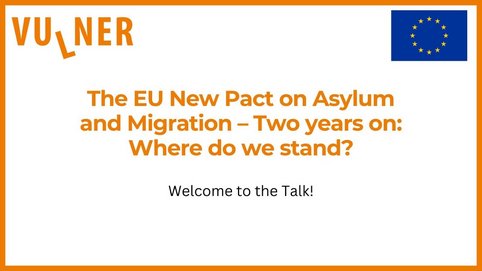The EU New Pact on Asylum and Migration Two Years On: Where do we Stand?
On September 22, 2022 from 17.00 to 18.15 CET, the VULNER project held a public discussion on ‘The EU New Pact on Asylum and Migration – Two years on: Where do we stand?’. The event was co-organized by Luc Leboeuf, VULNER’s scientific coordinator and Susanne Höb from Population Europe.

In September 2020, the EU Commission launched its ‘New Pact on Asylum and Migration’, which lays out the EU legislative and policy agenda for the years to come (COM, 2020, 609final).
The New Pact states, among other policy objectives, that ‘the EU asylum and migration management system needs to provide for the special needs of vulnerable groups’. It also announces specific protection measures for the most vulnerable asylum seekers and refugees, such as the exemption from accelerated border processes, relocation to another EU member state, or resettlement to the EU.
The VULNER talk took stock of the main policy developments at the EU level that occurred since the adoption of the New Pact and tried to identify suitable strategies to develop and implement specific protection measures for the migrants and refugees who find themselves in the most vulnerable positions.
Speakers:
Isabela Atanasiu, Legal Officer, DG Home Affairs, EU Commission
Cathryn Costello, Professor of International Refugee and Migration Law at the University of Oxford, and Co-Director of the Centre for Fundamental Rights at Hertie School Berlin
Marcus Engler, Researcher at the German Centre for Integration and Migration Research (DeZIM), Berlin, Germany
Julia Idler, Policy Advisor and Deputy Head of the Asylum Law and Asylum Procedure Unit, Federal Ministry of the Interior and Community (BMI), Germany
Geert Knockaert, Head of Asylum and Reception Cooperation and Guidance Unit, European Union Agency of Asylum (EUAA)
Marcus Engler, DeZIM, German Centre for Integration and Migration Research, Berlin, Germany
Sabrina Marchetti, Associate Professor at the Department of Philosophy and Cultural Heritage at the Ca’ Foscari University of Venice, Italy
Moderation:
Susanne Höb | Project Coordinator, Population Europe
VULNER Talk Series
The EU New Pact on Asylum and Migration – Two years on: Where do we stand?
Summary of the Discussion
Essential parts of the package to reform the Common European Asylum System are still debated controversially within and among the European and member state institutions. The experts discussed their expectations with regard to the recent state of the negotiations and their concerns about potential deficiencies, particularly in view of the situation of vulnerable migrants who are seeking protection.
Marcus Engler pointed out that even if there are considerable steps forward, such as the agreement of the Council of the European Union on the border screening mechanism in June 2022, the outcome of the deliberations is still quite open and difficult to foresee, given also that in some of the member states policies may potentially change towards more restrictive immigration regulations in the future. Other speakers, such as Isabela Atanasiu, Julia Idler and Geert Knockaert took a more optimistic view, turning to the achievements which have already been made in previous decades and most recently. The decision to go for a step-by-step instead of a purely package-driven approach would potentially help overcome stalemates in the negotiations. Atanasiu argued for strengthening the principles of responsibility but also solidarity among the member states, focusing on a constructive dialogue before turning to infringement procedures. She also argued for institutional setups which guarantee for the monitoring of the asylum procedures and, if necessary, sanctioning of abusive practices. Geert Knockaert reported on the support provided by the European Union Asylum Agency with “vulnerability toolkits”, expert networks and trainings to support the asylum authorities in their decision-making on vulnerable asylum-seekers. He emphasized that these tools have been developed together with member states and non-governmental organizations.
A second theme was the question of how we can better incorporate a vulnerability sensitive approach in EU migration and asylum policy. Isabela Atanasiu argued for a wide understanding of asylum seekers’ vulnerabilities to potentially include all those with “additional needs” of protection. E.g., unaccompanied and separated children and families with children under 12 years should be allowed to enter the European Union and have their asylum applications processed under a more protective framework than the envisaged border processes. From a member state perspective, Julia Idler endorsed the screening of vulnerability and analysing of the asylum applications at the earliest possible stage of the migration process, to offer adequate protection swiftly, and avoid that the regional and local authorities are overwhelmed with asylum applications.
From the perspective of the migrants who were surveyed within the VULNER project, Sabrina Marchetti focused on the deficiencies of current European asylum and migration policies, and the that are evolutions envisaged in the New Pact. In her view, it does not guarantee for a situational and holistic evaluation of vulnerable migrants seeking protection, and it does not take their heterogeneity sufficiently into account. As an example, she mentioned invisible and relational vulnerabilities, such as mothers with disabled children, as well as context-dependent vulnerabilities, e.g. after being exposed to criminal behaviors (human trafficking, bribing, etc). In particular, the envisaged asylum border process is likely to generate even more vulnerabilities, as the asylum-seekers would be confronted to intrusive interview situations upon arrival (as part of the border screening process, which would include a vulnerability assessment), and/or will be required to wait in overpopulated camps with further risks of violence. The evidence gained in the VULNER project underline the necessity of more careful, in-depth, evaluation procedures, even if those take more time. Similarly, Cathryn Costello emphasized the need to address the components of the EU asylum policy that generate vulnerabilities, such as the Dublin System. She argued that the activation of the temporary protection for Ukrainian refugees showed that there is an alternative, which grants mobility to asylum seekers and allows them to exercise their agency. A treatment, which respects their individual needs and dignity, would also contribute to establishing a higher level of acceptance, trust, and thus also compliance with the European asylum system. Marcus Engler supported the argument that the recent asylum policies create new vulnerabilities, particularly with harsh border regimes that contradict the common understanding of the European Union guaranteeing for a humane asylum protection.
These insights contributed to formulate the following VULNER recommendations:
-
Adopt a broad understanding of the vulnerabilities of the migrants seeking protection, to develop policies and practices that are sensitive to its many manifestations and patterns
-
Proceed those asylum seekers that have been identified as particularly vulnerable into a more protected environment during the assessment of their asylum application, to avoid further traumatization
-
Enhance the capacities of border control authorities to better evaluate vulnerabilities in their complex, situated and intersecting dimensions
-
Reconsider the limitations of the Dublin system, which often contributes in putting asylum seekers in vulnerable positions by prolonging the asylum process and uncertainties
-
Integrate evidence taken from research and surveys into the framing of future asylum policies

